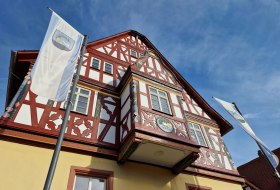
searchMenu


Multimedia offer guides you through the imperial palace of Ingelheim! The Kaiserpfalz App is available free of charge at Google Play and in the AppStore (to be found under the keyword "Kaiserpfalz Ingelheim"). The app supplements the signage and accompanying booklet with a digital guide through the Kaiserpfalz region, which provides audio texts and picture galleries, among other things. Thus, the Kaiserpfalz can be experienced digitally at any place and at any time.

The town hall in Bodenheim is a typical example of the Franconian-Hessian half-timbered construction style of the Renaissance around 1600 and is considered one of the most beautiful half-timbered houses in Rheinhessen. The renovation was completed in 2023; it now shines in new splendour in the old town centre of the wine-growing community of Bodenheim. It was built in 1608 under the then lord of the village, Provost Anton Walpot von Bassenheim, as a new courthouse for the Mainz Knights' Abbey of St Alban. In the bay window, we recognise the…

In 1855, the foundation stone was laid for the construction of the synagogue, which the local community acquired in 1900 for use as a kindergarten. Only until 1874 did the synagogue serve as a church. Thereafter, the building became the property of the Protestant parish, which originally wanted to demolish it to build a parish hall here. However, due to the objection of the state preservation of monuments, it did not happen. Even today, the synagogue is used as a Protestant parish hall.

The high altar of the Barock church includes a wonderful figure of Mary made of Lime-wood which was made along the Oberrhein about 1470. It probably comes from the previous building which, in the Middle Ages, was a pilgrims hospital along the Jakobsweg.

The Schneiderturm tower, which stood beneath the Landskron castle complex, was destroyed in 1689. In 1903, it was rebuilt in its current form, with the exterior façade clad in the same stone material as the Oppenheim district court. Thanks to the voluntary commitment of the “Förderverein Ruprechtsturm” (Ruprecht Tower Support Association), a comprehensive and fundamental renovation of the accessible observation tower was made possible. Guided tours are available on request from the Oppenheim Tourist Information…

The Bornheim lookout tower is located in the middle of the sea of vines and offers a wide view over Rhine-Hessian Switzerland. This is also the location of the "Hiwwelrast", a wine tasting stand run by the surrounding winegrowers.

